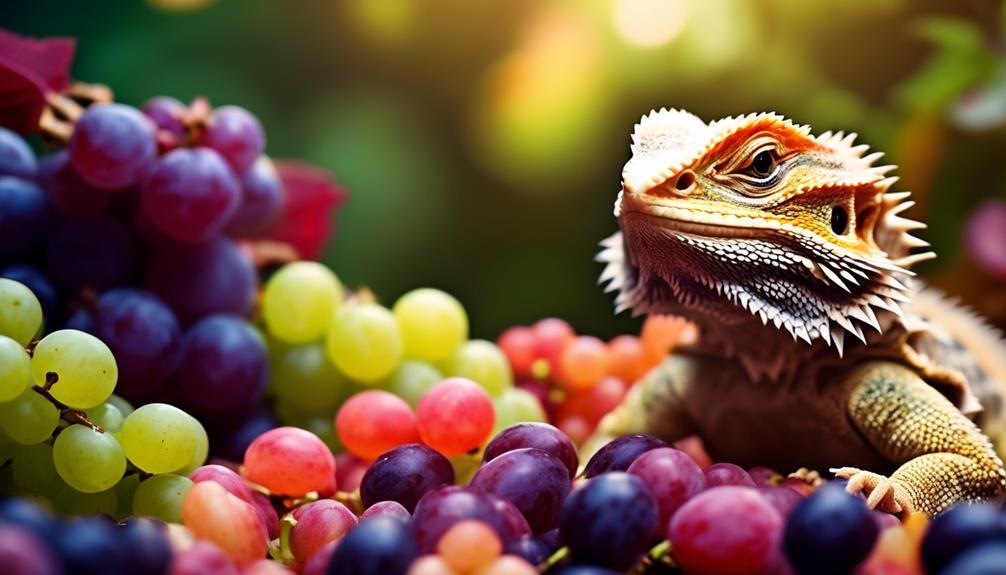Are you ready to dive into the fascinating world of the breeding cycle of bearded dragons?
Get ready to witness the intricate dance of courtship, the hormonal changes that signal readiness to mate, and the remarkable techniques used during the mating process.
Explore the development and formation of eggs and the meticulous process of nesting and egg-laying.
Finally, marvel at the incubation and hatching period, where new life emerges.
Prepare to be captivated by the wonders of nature's most remarkable creatures.
Key Takeaways
- Courtship and mating behavior in bearded dragons involves head bobbing, arm waving, puffing up throats, tail curling, and licking.
- Hormonal changes, such as increased progesterone and testosterone levels, play a role in readiness to mate and trigger behavioral changes.
- Understanding egg development and formation is crucial, including cell division, organogenesis, nutrient absorption, and maintaining proper temperature and humidity.
- Factors affecting egg viability include temperature fluctuations and humidity levels, with stable and ideal conditions promoting successful development.
Courtship and Recognition
Now let's delve into how bearded dragons attract mates and identify potential partners during their breeding cycle.
Courtship rituals play a crucial role in the mate selection process of these fascinating reptiles. Male bearded dragons exhibit a series of behaviors to attract females, including head bobbing, arm waving, and even puffing up their throats to display dominance and attractiveness.
These courtship rituals not only serve to impress the female, but also allow the male to assess the female's receptivity to mating. Females, on the other hand, carefully observe and evaluate the male's displays to determine their suitability as a mate.
Through these courtship rituals, bearded dragons establish a connection and ensure compatibility before proceeding to the next stage of their breeding cycle.
Transitioning into the subsequent section, let's now explore the hormonal changes that occur in preparation for mating.
Hormonal Changes and Readiness to Mate
To understand the breeding cycle of bearded dragons, you must first recognize the hormonal changes that occur as they prepare to mate. Hormonal cues play a crucial role in signaling reproductive readiness in these reptiles.
When a female bearded dragon is ready to mate, her body undergoes a series of changes. One of the key hormones involved in this process is progesterone, which increases in concentration during the breeding season. This hormone stimulates the development of follicles in the female's ovaries, leading to ovulation and the release of eggs.
In males, testosterone levels rise, triggering behavioral changes such as increased aggression and territoriality. These hormonal changes are essential for successful mating and reproduction in bearded dragons.
Mating Behavior and Techniques
When it comes to mating behavior and techniques, you'll find that bearded dragons exhibit fascinating rituals and utilize various techniques to attract and court potential mates. These behaviors play a crucial role in their reproductive patterns and ultimately determine the success rates of mating.
Here are some key behaviors and techniques observed in bearded dragon mating:
- Head bobbing: Male bearded dragons perform rapid vertical head movements to display dominance and attract females.
- Arm waving: Males will extend and wave their forelimbs to signal their readiness to mate.
- Tail curling: Both males and females may curl their tails to show interest and readiness for mating.
- Licking: Males often lick the females to stimulate courtship and initiate mating.
Understanding these mating behaviors and techniques is essential in recognizing the signs of successful courtship and mating in bearded dragons. It sets the stage for the subsequent section on egg development and formation, where the next phase of the breeding cycle begins.
Egg Development and Formation
Now let's explore the fascinating process of egg development and formation in bearded dragons.
Embryo growth and development play a crucial role in the successful hatching of eggs.
Understanding the factors that affect egg viability will provide valuable insights into ensuring the health and survival of the next generation of these remarkable reptiles.
Embryo Growth and Development
During the incubation period, an embryo typically undergoes significant growth and development inside the egg. This is a critical stage in the breeding cycle of Bearded Dragons, as it lays the foundation for the healthy development of the offspring. Here are some important aspects of embryo growth and development:
- Cell division: After the fertilization process, the embryo starts as a single cell and rapidly divides into multiple cells, forming the basis of different organs and body systems.
- Organogenesis: As the embryo develops, various organs and body structures begin to form, including the heart, brain, limbs, and digestive system.
- Nutrient absorption: The embryo obtains essential nutrients from the yolk sac, which provides nourishment for its growth and development.
- Prenatal care: Proper temperature and humidity levels during incubation are crucial for the embryo's survival and healthy development.
Understanding the intricacies of embryo growth and development allows for better prenatal care, ensuring the well-being and vitality of the future generation of Bearded Dragons.
Factors Affecting Egg Viability
To ensure optimal egg viability, you must consider both the temperature and humidity levels in the incubation environment. Genetic influences on egg viability play a significant role, as certain genetic factors can affect the development and formation of bearded dragon eggs. However, environmental factors also greatly impact egg viability. Temperature fluctuations can have detrimental effects on egg development, as extreme temperatures can lead to the death of the embryos. On the other hand, maintaining a stable temperature within the appropriate range promotes successful egg development. Humidity levels are equally important, as excessive or insufficient humidity can cause problems such as dehydration or fungal growth. By providing the ideal temperature and humidity conditions, you can greatly improve the chances of successful egg development and hatching.
| Environmental Factors | Impact on Egg Viability |
|---|---|
| Temperature | Extreme temperatures can lead to embryo death, while stable temperatures within the appropriate range promote successful development. |
| Humidity | Excessive or insufficient humidity can cause dehydration or fungal growth, negatively affecting egg viability. |
Nesting and Egg-laying Process
When it comes to nesting and laying eggs, bearded dragons exhibit fascinating behaviors. During the breeding season, female bearded dragons undergo changes in their reproductive anatomy to prepare for egg-laying.
Here is what you need to know about their nesting and egg-laying process:
- Digging: Female bearded dragons create burrows in soft soil or sand to lay their eggs. This behavior helps protect the eggs from predators and provides a stable environment for incubation.
- Nesting Site Selection: Bearded dragons are selective about their nesting sites. They prefer areas with ample sunlight and optimal temperature and humidity levels.
- Egg-laying: Once the nest is prepared, the female bearded dragon lays her eggs. The number of eggs laid can vary, with an average clutch size ranging from 15 to 30 eggs.
- Covering the Eggs: After laying her eggs, the female carefully covers them with soil, concealing them from potential threats.
Understanding the nesting and egg-laying process is crucial for successful breeding and egg incubation.
Now let's explore the next stage: the incubation and hatching period.
Incubation and Hatching Period
Now that the eggs have been laid, it's crucial to understand the incubation and hatching period of bearded dragons.
One important factor to consider is the optimal incubation temperature, which plays a significant role in the development of the embryos.
Additionally, observing the hatching behavior and signs can provide valuable insights into the progress and readiness of the eggs to hatch.
Optimal Incubation Temperature
During the incubation and hatching period of bearded dragons, you should strive for an optimal temperature range. Maintaining the correct temperature is crucial for successful embryonic development and accurate gender determination. Here are some key points to consider:
- Temperature range: The optimal temperature for incubating bearded dragon eggs is between 82°F and 86°F (28°C and 30°C).
- Temperature fluctuations: Avoid drastic temperature fluctuations as they can negatively impact the development of the embryos.
- Heat source: Utilize a reliable heat source, such as an incubator or heat mat, to maintain a consistent temperature throughout the incubation period.
- Temperature monitoring: Regularly monitor the temperature using a reliable thermometer to ensure it remains within the desired range.
Hatching Behavior and Signs
To ensure a successful hatching period, you must closely observe the behavior and signs exhibited by bearded dragon eggs. The incubation and hatching period is a critical time for the development of the baby bearded dragons, and understanding their behavior can help you provide the necessary care.
During incubation, it's important to regulate the temperature within the incubator to ensure proper growth and development. The optimal temperature for incubation is around 84 to 88 degrees Fahrenheit.
As the eggs near the hatching period, you may notice some signs such as increased movement within the egg and even slight pipping or cracking of the shell. It's crucial to provide parental care during this time by maintaining the appropriate temperature and humidity levels in the incubator.
Additionally, avoid handling the eggs excessively as this can disrupt their natural hatching process. By closely observing these hatching behaviors and providing the necessary care, you can ensure the successful hatching of your bearded dragon eggs.
Frequently Asked Questions
How Long Does the Courtship and Recognition Phase Typically Last in Bearded Dragons?
During courtship, male bearded dragons undergo behavioral changes. The courtship duration typically lasts for a specific period. These changes are important for the recognition phase and play a crucial role in the breeding cycle.
What Are the Specific Hormonal Changes That Occur in Female Bearded Dragons When They Are Ready to Mate?
When female bearded dragons are ready to mate, specific hormonal changes occur. These changes play a crucial role in their reproductive cycle. Factors such as age, health, and environmental conditions can also affect their mating success.
Can Bearded Dragons Mate With Multiple Partners During a Breeding Season?
During a breeding season, bearded dragons have the ability to mate with multiple partners. This mating behavior is influenced by their hormonal changes and natural instincts to increase their chances of successful reproduction.
How Long Does It Take for Bearded Dragon Eggs to Develop and Form After Mating?
Did you know that the development timeline of bearded dragon eggs after mating varies? Factors like temperature and humidity can influence the process. Let's explore the fascinating world of bearded dragon egg development together!
Do Bearded Dragons Always Lay Their Eggs in a Specific Type of Nesting Site?
Bearded dragons typically have nesting preferences and tend to choose specific types of nesting sites. They also have a preferred temperature for nesting, which helps ensure the successful development of their eggs.
Conclusion
In conclusion, the breeding cycle of bearded dragons is a complex and fascinating process. From courtship and recognition to hormonal changes and mating behavior, every step is crucial for successful reproduction.
The meticulous egg development and formation, followed by the nesting and egg-laying process, demonstrate the careful nurturing instinct of these reptiles.
Lastly, the incubation and hatching period marks the culmination of their reproductive journey. Understanding and appreciating the intricacies of the bearded dragon's breeding cycle enhances our knowledge of these remarkable creatures.


